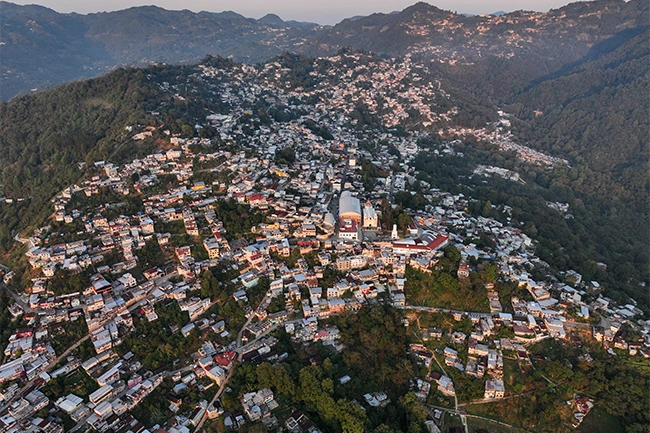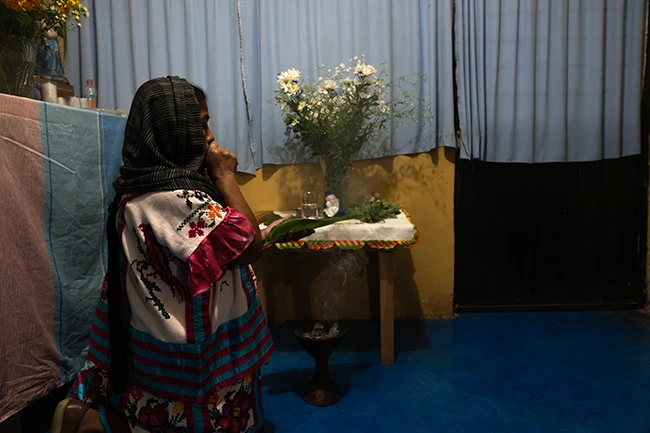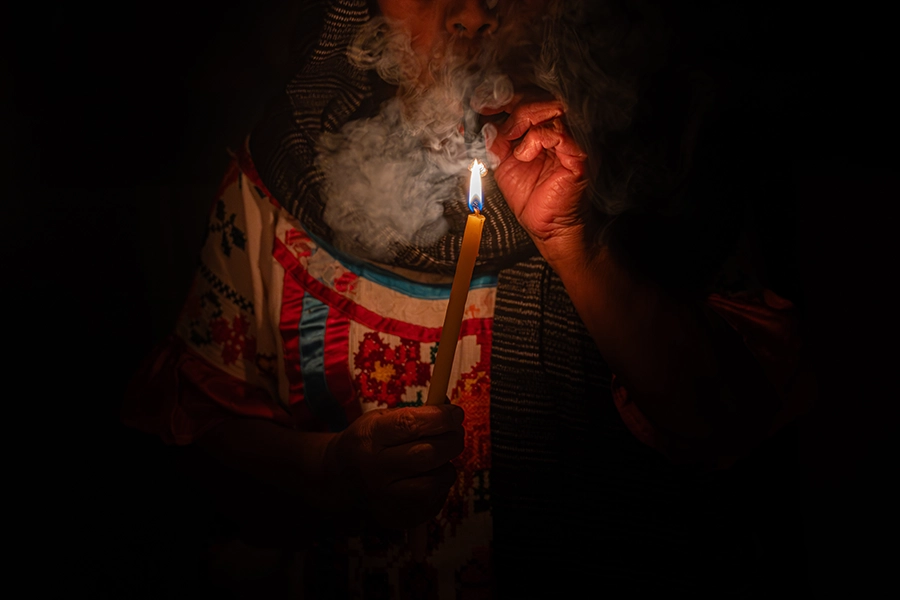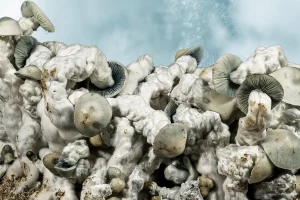Asunción Calixto* kneeled on the floor of her parents’ house in Huautla de Jiménez, nestled between the mountain ranges and verdant valleys of the Sierra Norte in Oaxaca, Mexico. Sitting across from her was her then-boyfriend, and with them, a curandero (healer) he arranged to serve her mushrooms for the first time. It was nightfall. She remembers smelling burning incense and the curandero passing herbs over her body.
At first, her journey was enchanting—filled with vivid and light-hearted imagery that whirled through her conscience. “I saw many beautiful colors and indescribable animals like alebrijes with pretty little wheels surrounded by diamonds,” she describes. But then, little details about her life began to emerge, details she was afraid of revealing to her boyfriend: childhood moments where she was assaulted by a relative and a period when she lived in Veracruz and was in another relationship. As she shared, her boyfriend—who had a history of physically and mentally abusing her —slapped her. He wanted to know about her other relationships, about pieces of her life story that she had never been comfortable enough to reveal to him.
“He used the mushrooms to learn more about me. I think his insecurities killed him,” she explains.
Her awareness broke into fragments, but she remembers the curandero not intervening. Her partner had agreed with him not to step in, no matter the cost. Calixto felt a stabbing inner pain, and nobody guided her through the shadowy experience. At some point, her boyfriend and the curandero left.
She continued journeying, alone, until dawn. “I was lost, and I didn’t stop traveling until I could pick myself up to eat,” she describes.
She let 15 years—and many lifetimes—pass before taking the sacred mushrooms again.

Violence against women is a longstanding issue in Mexico. A survey conducted in 2021 by the National Institute of Statistics and Geography revealed that 70 percent of women ages 15 and above in the country have experienced some form of violence in their lives. Indigenous women are disproportionately susceptible to violence due to traditional patriarchal social structures—a machista culture that at times normalizes abuse like what Calixto suffered. Like the Mazatec, indigenous communities are also marginalized within the greater Mestizo-Spanish-dominated Mexican society. This causes social disparities which contribute to alcohol dependence and, consequently, domestic violence, mental health challenges, and trauma.
Amidst all of this—and a growing interest among foreigners in the traditional use of mushrooms in Huautla—curanderas quietly do their work far away from peering eyes, helping women like Calixto. One of them is Margarita López*.
For over 20 years, López took Calixto to quiet places—small huts deep within the mountains surrounding Huautla—as she chipped away at her trauma. The ceremonies were always indoors and at nightfall, just the two women alone. López would light candles and cut laurel leaves to cleanse Calixto before they would take the mushrooms together, the traditional Mazatec way.


Under the effects of the mushrooms, López would sing and pray. They were always close, a striking difference from Calixto’s first experience with a curandero she had never met.
How to Grow Shrooms Bundle
Take Both of Our Courses and Save $90!
In their initial trips together, as Calixto continued to cultivate a relationship with the mushrooms, she began to relive that first experience—and remember abuse stemming back to her childhood. She relived being raped by a relative when she was younger. The mushrooms also brought back memories of abuse in her family. She remembered her brothers brutally mistreating her younger sister, and no one in the family stopping them. Her eldest brother—an alcoholic—was particularly abusive.
A study conducted by the National Indigenous Institute in 2021 found that alcohol dependence is a significant factor in violence and family breakdown among indigenous communities in Mexico. According to the report, 25 percent of indigenous people report having alcohol dependence. This is two and a half times higher than the national average. Several factors contribute to this, including colonization—which brought alcohol into these areas—poverty, discrimination and stigmatization, and lack of access to education and healthcare.
The report also states that alcohol is a significant factor in domestic violence and is involved in up to 60 percent of domestic violence cases among indigenous peoples—and this doesn’t account for everyone. Many gender-related violence cases go unreported to the police, according to the Observatorio Ciudadano Nacional del Feminicidio (Mexico National Citizen Observatory of Femicide). Mexican human rights groups say the root causes behind this include corruption and inadequately equipped justice systems, especially in more remote communities. Today, the cycles of poverty, alcoholism, and abuse are growing—and, in some cases, psychedelic tourism has only made things worse.
Dr. Osiris García Cerqueda, a researcher, historian, and member of the Mazatec community from Huautla, has worked with his community for over a decade to document their practices of sacred mushrooms, including how these traditions are used to treat modern traumas. He says there are tensions in Huautla within the local population due to competition within the burgeoning industry to provide mushroom experiences to foreigners—and that this has led to greed and corruption. These tensions, he says, have also strained relations between regional political groups, transforming the region’s economy. Traditional forms of work have been displaced, creating new forms of poverty—and, in doing so—perpetuating mental health challenges.


This is where curanderas like López come in. Even though Huautla has become a popular tourist destination for psychedelic seekers—and there’s been a rise in healers, some authentic and some inauthentic, to serve them—there are also curanderas who will only serve their immediate community, “anonymous” curanderas, as García calls them.
López, who is 65 years old, keeps herself hidden from tourists, researchers, and the like. She worries that someone will attack her spiritually if they discover her abilities, something that happened not so long ago with Maria Sabina, the curandera credited with making Huautla famous to the world. After she was featured in a 1957 issue of LIFE magazine holding a ceremony for a Western banker by the name of R. Gordon Wasson, the town became overrun by tourists and locals—angered by the visibility—murdered her son and burned her house to the ground. Although she’s widely considered the reason why the West knows about the healing potential of psilocybin-containing mushrooms, Sabina died penniless.
López remembers the time before this visibility, when Huautla was yet to be discovered by outsiders. As a child, she was trained to be a curandera in the traditional Mazatec ways and, at the time, towns like Huautla—and the communities that lived in them—were considered remote, because they were in hard-to-access, mountainous areas. Then, the region—and its culture and traditions—opened up to exposure from research and tourism as communities and towns urbanized and developed.
Still, anonymous curanderas like López work to protect their traditions, even as the society around them changes—and they navigate the dilemmas and social issues that come with both modernity and ancient patriarchal structures in their healing practices. Curanderas are needed in these communities as much as ever.


Mental health issues are not only rampant—but seeking treatment among the Mazatec is taboo. “The Mazatec people do not see mental health professionals, and in the Mazatec Sierra, there are few clinical specialists,” says García. “It is believed that these professions only exist to care for people who suffer from ‘craziness.’ Whoever decides to go with these professionals will do so in the cities and secretly.”
Mushrooms—considered sacred by the Mazatec—still provide the only socially acceptable solution for treating mental health issues in these communities. “Some families go to curanderos to cure their children of alcoholism so they can be better husbands and fathers,” Garcia adds. “That is how some people reduce the problem of domestic violence, alcoholism, and drug addiction, although this is not an immediate or definitive solution. Even with this, machismo prevails. In the Mazatec context, machismo is deeply rooted. There are cases of violence against women that are rarely dealt with.”
For centuries, and as an aspect of their culture, religion, and identity, the Mazatec have used mushrooms—which they refer to as Ndi xij’to (“little things that sprout from the ground”), and other psychoactive plants to cure physical, mental, and spiritual ailments. There are specific periods and days where mushroom ceremonies are carried out, and healing is only one aspect of their identity; the ritual and community practice of these ancient traditions is also considered a form of resistance of the Mazatec people to capitalist modernity and outside influence.
The Mazatec do not believe in “psilocybin” (the primary psychoactive compound in mushrooms which has been isolated and synthesized by Western researchers) or that their use of mushrooms is scientific. Instead, says Mexican anthropological researcher Dr. Sarai Piña Alcántara, they consider the mushrooms a deity, a conscious being believed to have a spirit, voice, and intention. Upon ingesting the mushrooms, they believe the deity possesses the person’s body. “The mushroom is [also] a communication bridge with the spiritual world and other beings such as chikones [guardians of different natural places],” explains Piña.
According to García, traditional Mazatec curanderos view the healing of alcohol dependence, trauma, or depression—mental health challenges—similarly to any other health issue rather than distinct (i.e. a psychological ailment vs. a physiological one). A person’s ability to heal with mushrooms is largely dependent upon them coming into ceremony “clean” and free of substances—and how safe and supported they feel.
The intimate relationship between Calixto and López was key to Calixto’s healing. In the mountains, she cried until she felt every emotion drain from her body, as López prayed to the guardians for her. The curandera would ask the guardians to “purify her, to return her to the way she was, that she not suffer this anxiety and anguish.” She gently guided Calixto to ask for her own healing as well.
Calixto screamed in suffering and released tears watching her little sister be beaten—over and over. Finally, everything became clear. Because of the sacred mushrooms, she brought her sister’s case before the District Attorney’s office and helped her sister sue the two brothers who almost beat her to death. They also packed up their belongings and left.


López, for her part, sees herself as paying it forward. She also experienced violence and abuse and watched her son Ernesto* deteriorate because of alcoholism. The curandera used sacred mushrooms and other plant therapies to cure herself from the violent abuse and to help her son overcome his substance dependence. Over the last thirty years, she has created a network of community aid for women like her and Calixto, who are survivors of domestic violence.
How to Grow Shrooms Bundle
Take Both of Our Courses and Save $90!
At 52 now, Calixto has made peace with the trauma she has endured. Though dimmed with age, her dark brown eyes are intense and focused. She has soft dark hair swept into a bun, and wears a red, wool sweater and a long blue skirt that covers her knees. She listens intently when spoken to, taking in every word, breath, and detail. While reflective in moments, she is also an evocative, charismatic storyteller who readily recounts her life experiences using lots of sweeping gestures with her hands.

Calixto still takes mushrooms multiple times yearly to work through the remnants of her trauma and cure other illnesses. Culturally, she understands the importance of the mushroom and curanderas like López, saying she couldn’t have healed her fear without them.
Meanwhile, López’s focus is now on the next generation. She trained her son as a child to be a curandero to serve their community and explains that many other local curanderos will train their children, too. As is often the case in indigenous communities, the younger generation often aspires to leave for big cities and pursue other types of work, but there’s also a group, López says, who returns each year, when the mushrooms are in season, to conduct ceremonies. This is essential, she says, for ensuring that the Mazatec way of life is preserved.
“For us Mazatecs,” she says, “the sacred mushrooms cure everything.”
*names have been changed for anonymity
This article was originally published in DoubleBlind Issue 10.
Safety Note
Domestic abuse victims in North America and US Territories can call the National Domestic Violence Hotline at +1-800-799-7233 (+1-800-799-SAFE) for 24-hour help. You can also access text and chat services through thehotline.org.
Español: espanol.thehotline.org

DoubleBlind is a trusted resource for news, evidence-based education, and reporting on psychedelics. We work with leading medical professionals, scientific researchers, journalists, mycologists, indigenous stewards, and cultural pioneers. Read about our editorial policy and fact-checking process here.

DoubleBlind Magazine does not encourage or condone any illegal activities, including but not limited to the use of illegal substances. We do not provide mental health, clinical, or medical services. We are not a substitute for medical, psychological, or psychiatric diagnosis, treatment, or advice. If you are in a crisis or if you or any other person may be in danger or experiencing a mental health emergency, immediately call 911 or your local emergency resources. If you are considering suicide, please call 988 to connect with the National Suicide Prevention Lifeline.



